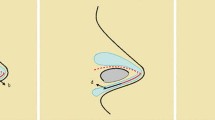Abstract
Closed rhinoplasty is currently losing favour as a method of rhinoplasty reshaping procedure. Open rhinoplasties are usually performed by surgeons because of the greater degree of visualisation of the cartilages and bones within the nose that need to be reshaped. Because of the criticisms of closed rhinoplasty the senior author performed an audit of his outcomes to determine whether closed rhinoplasty still has a role to play in the armamentarium of the plastic surgeon. We conducted this study as a retrospective review of all closed rhinoplasty operations performed by a single surgeon over a two-year period (from 1st January 2016 to 31st December 2017). The operative technique is provided. An independent panel of 3 assessors (2 board certified consultant plastic surgeons and one lay member of the public) rated outcomes of the closed technique based on photographic series. Statistical analysis was performed using Cohen’s Kappa and Friedman test. Additionally, the length of follow up period, revision rates, and post-operative complications (general and aesthetic) were examined. A total of 242 cases of rhinoplasty were performed (8 open and 234 closed rhinoplasty; 225 primary and 17 revision operations). The first consultant surgeon gave a score in a range from 4.2/5 to 4.9/5 with a mode of 4.8 and a mean score of 4.7/5. The second consultant surgeon gave a range of 4.1/5 to 4.9/5 with a mode of 4.4 and mean score of 4.3/5. The lay panel member scored the cases in a range from 4.4/5 to 5/5 with a mode of 4.8 and a mean score of 4.9/5. Cohen’s coefficient was 0.72 showing substantial agreement across the panel. The complication rate for the recorded data was 0.8% with two cases of soft tissue infection treated with oral antibiotics. The results of this paper advocates the benefits of the closed approach in aesthetic rhinoplasty. Surgeons should appreciate that both open and closed approaches are complimentary. The favouring of a single approach is indicated in the scenarios discussed. The remaining cases seem to produce equivocal results and the choice of procedure should be based on patient anatomy, outcome aims, and the ability of a surgeon to perform their preferred technique.



Similar content being viewed by others
References
Alexander R (1995) Fundamental terms, considerations, and approaches in rhinoplasty. Atlas Oral Maxillofac Surg Clin N Am 3:15–25
Berghaus A (2016) Modern rhinoplasty: is there a place for the closed approach? JAMA Facial Plast Surg 32:402–408
Tasman A (2007) Rhinoplasty-indications and techniques. GMS Curr Top Otorhinolaryngol Head Neck Surg 6:Doc09
Tebbetts JB (2006) Open and closed rhinoplasty (minus the “versus”): analyzing processes. Aesthet Surg J 26:456–459
Foda H (2003) External rhinoplasty: a critical analysis of 500 cases. J Laryngol Otol 117:473–477
Burke A, Cook T (2000) Open versus closed rhinoplasty: what have we learned? Curr Opin Otolaryngol Head Neck Surg 8:332–336
Cafferty A, Becker DG (2016) Open and closed rhinoplasty. Clin Plast Surg 43:17–27
Bagheri S, Khan H, Jahangirnia A, Rad S (2012) An analysis of 101 primary cosmetic rhinoplasties. J Oral Maxillofac Surg 70:902–909
Rettinger G (2008) Risks and complications in rhinoplasty. GMS Curr Top Otorhinolaryngol Head Neck Surg 6:Doc08
Perkins S, Patel A (2009) Endonasal suture techniques in tip rhinoplasty. Facial Plast Surg Clin N Am 17:41–54
Nguyen P et al (2014) Surgical approaches in rhinoplasty. Annales de Chirurgie Plastique Esthétique 59:406–419
Acknowledgements
The authors would like to acknowledge the help of Maliha Shoaib in preparing this manuscript.
Funding
The author can confirm of no funding interests.
Author information
Authors and Affiliations
Corresponding author
Ethics declarations
Conflict of interest
Authors can confirm no conflict of interest.
Additional information
Publisher's Note
Springer Nature remains neutral with regard to jurisdictional claims in published maps and institutional affiliations.
Rights and permissions
About this article
Cite this article
Azzawi, S.A., Kidd, T. & Shoaib, T. Closed Rhinoplasty: A Single Surgeon Experience of 238 Cases over 2 Years. Indian J Otolaryngol Head Neck Surg 74, 255–259 (2022). https://doi.org/10.1007/s12070-020-01990-y
Received:
Accepted:
Published:
Issue Date:
DOI: https://doi.org/10.1007/s12070-020-01990-y




